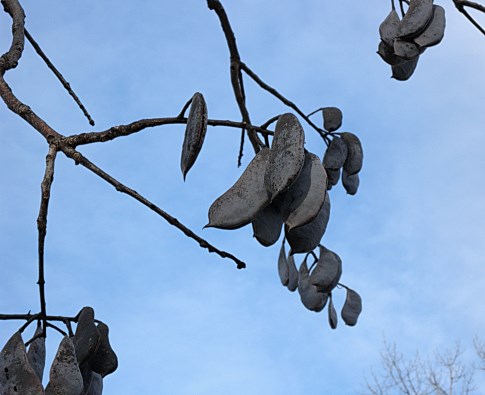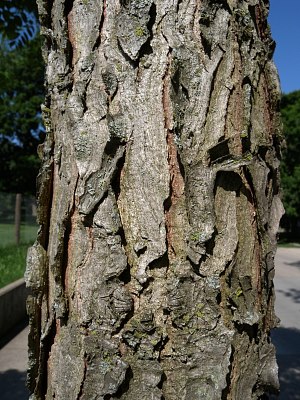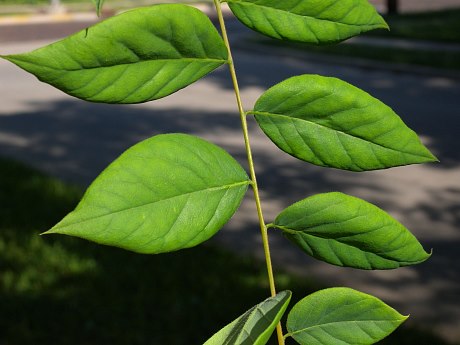
Kentucky Coffee Tree is dioecious or polygamo-dioecious; individual trees have either all male flowers, all female flowers, or perfect flowers. These greenish white flowers develop in pyramidal racemes on short terminal branches shortly after the leaves have already developed. Panicles with male flowers are 3-4" long, while panicles with female or perfect flowers are 6-12" long. Individual flowers are about ¾" long, consisting of a narrow tubular calyx with 5 narrow petaloid lobes, 5 narrow petals, 10 fertile stamens (male & perfect flowers only), and a fertile ovary with a single style (female & perfect flowers only). The interior of the petals and petaloid calyx lobes are white and finely pubescent; they spread widely when individual flowers are in bloom. The exterior of the tubular calyx is light green to reddish green. The pedicels become longer than the flowers with age. The blooming period occurs from late spring to early summer and lasts about 2-3 weeks. The flowers have a mild fragrance.

Fertile flowers are replaced by flattened seedpods that are 3-6" long and 1½-2" at maturity. The seedpods become mature during the autumn and persist on the tree through the winter. Their exterior is dark reddish brown to nearly black and hairless. Each seedpod contains 3-6 seeds that are immersed in a sweet gelatinous substance. Individual seeds are about ½-¾" long, globoid-ovoid, and slightly flattened. The hard exterior coat of the seeds is dark brown. The deciduous leaves turn yellow before falling to the ground in early autumn.
Cultivation: The preference is full to partial sun, moist to mesic conditions that are well-drained, and a fertile loamy soil with abundant organic material. Young trees grow fairly quickly, while older trees grow more slowly. This tree often appears to be dead because it is leafless from mid-autumn to mid-spring.. There are very few problems with disease organisms and insect pests.
Range & Habitat: The native Kentucky Coffee Tree is scattered throughout Illinois, although it is fairly uncommon (see Distribution Map). Habitats include rich mesic woodlands, bottomland woodlands, and riverbanks. This tree is found in deciduous woodlands, where it occurs as scattered individuals or in small colonies. It is never one of the dominant canopy trees. To an increasing extent in recent years, Kentucky Coffee Tree is cultivated as a trouble-free landscape tree that tolerates urban conditions.

Faunal Associations: The flowers are cross-pollinated by bumblebees (Bombus spp.), long-horned bees (Synhalonia spp.), butterflies (Tiger Swallowtail & probably other species), and the Ruby-Throated Hummingbird (see Robertson, 1929). These visitors obtain nectar from the flowers primarily, although some bees also collect pollen. The caterpillars of Sphingicampa bicolor (Honey Locust Moth) and Sphingicampa bisecta (Bisected Honey Locust Moth) feed on the foliage of Kentucky Coffee Tree. Among vertebrate animals, groundhogs have been observed to eat the seedlings. Otherwise, this tree is avoided by mammalian herbivores because the seeds and leaves are toxic. When the leaves and seedpods have fallen into ponds, cattle that drink the water have been fatally poisoned. There is some speculation that the seedpods may have been eaten by the extinct American Mastodon and possibly other Ice Age mammals. This is because the seedpods are filled with a sweet gelatinous substance, while the seed coats are extremely hard and thus could resist being crushed by the molars of an elephant and other large mammals. If this is true, such mammals would have transported the seeds considerable distances to colonize new areas (see discussion at Kock et al., 2008).
Photographic Location: A young landscape tree along a street in Urbana, Illinois.

Comments: Kentucky Coffee Tree has the largest leaves of any native tree is Illinois. The common name refers to either the resemblance of its seeds to coffee beans, or the use of roasted seeds by pioneers in making a substitute for coffee. It is the only species of its genus in North America; there is one other Gymnocladus sp. in China. The nearest relative of Kentucky Coffee Tree in Illinois is probably Gleditsia triacanthos (Honey Locust), which also has bipinnate leaves and similar seedpods that are filled with a sweet gelatinous substance. Honey Locust is easily distinguished from the former tree by its smaller subleaflets (¾-1½"), longer and more twisted seedpods (6-18" in length), shorter racemes of the female flowers, less furrowed and scaly bark, and the presence of thorns on its trunk and branches (except for thornless cultivars).